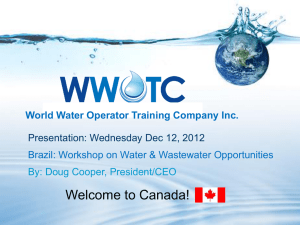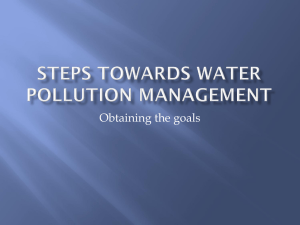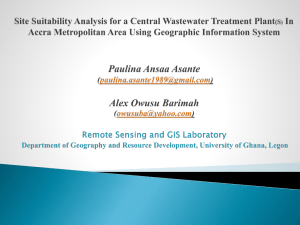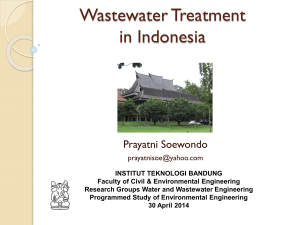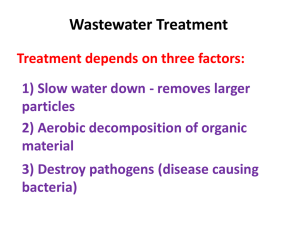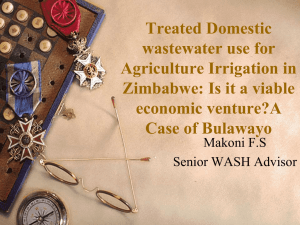PowerPoint File, 10,55 MB - UN-Water Activity Information System!
advertisement
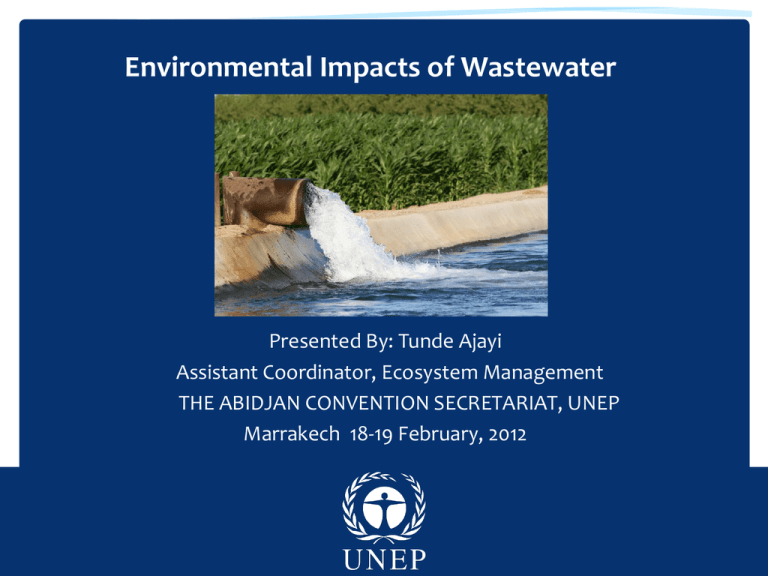
Environmental Impacts of Wastewater Presented By: Tunde Ajayi Assistant Coordinator, Ecosystem Management THE ABIDJAN CONVENTION SECRETARIAT, UNEP Marrakech 18-19 February, 2012 Sick Water Definition of Wastewater A combination of one or more of: - domestic effluent consisting of blackwater (excreta, urine and faecal sludge) and greywater (kitchen and bathing wastewater); - water from commercial establishments and institutions, including hospitals; - industrial effluent, stormwater and other urban run-off; - agricultural, horticultural and aquaculture effluent, either dissolved or as suspended matter (definition adapted from Raschid-Sally and Jayakody, 2008) • Unregulated discharge of wastewater undermines biological diversity, natural resilience and the capacity of the planet to provide fundamental ecosystem services, impacting both rural and urban populations and affecting sectors from health to industry, agriculture, fisheries and tourism Growing populations Urbanisation: 3.4 6.4 Billion by 2050 – most in smaller cities -One in 3 city dwellers live in slums, and 2.6 billion lack adequate sanitation worldwide Sewage systems are already lacking, underdimensioned or decayed Improved sanitation and wastewater management are central to health, labor productivity and thus poverty reduction. Impacts of Wastewater - Soil resources - Groundwater - Run-off to water bodies - Ecological impacts - Economic impacts Impacts of Wastewater Loss of Biodiversity In 1960 there were 9 documented hypoxic zones The number of hypoxic areas has doubled every decade since then In 2007, 415 eutrophic and hypoxic coastal systems worldwide were identified • Dead zones are now thought to affect more than 245 000km2 of marine ecosystems, predominantly in the northern hemisphere (Diaz and Rosenberg, 2008) Impacts of Wastewater Loss of food security • Degradation of ecosystems services - impacts on fisheries, livelihoods and the food chain. • 275 million people depend directly on reefs for livelihoods and sustenance • Healthy reefs can produce up to 35 tons of fish per square kilometer each year. There is a catch reduction of 67 tons for every square kilometer of clear-cut mangrove forest Impacts of Wastewater Loss of blue carbon sinks • Healthy coastal ecosystems decrease vulnerability to climate change effects and extreme events, and save e.g. infrastructure related costs • Healthy mangroves, seagrass beds and salt marshes are globally important CO2 sinks, but become sources of emissions when degraded • Wastewater-related emissions of methane (CH4) and nitrous oxide (N2O), could rise by 50 per cent and 25 per cent respectively between 1990 and 2020 The Sick water report was compiled by a special taskforce consisting of: - - • • United Nations Environment Programme (UNEP), UN Human Settlements Programme (UN-HABITAT), the UN Secretary General’s Advisory Board on Water and Sanitation (UNSGAB), experts from UN Water Experts from UNEP’s GRID Arendal in Norway, The report identifies the threats to human and ecological health and the consequences of inaction, It also presents opportunities, where appropriate policy and management responses over the short and longer term can trigger employment, support livelihoods, boost public and ecosystem health and contribute to more intelligent water management.” Targeted and sustained investments are necessary – they should be designed to: -Reduce volume and extent of water pollution -Capture water once polluted -Treat polluted water for return to environment -Safely reuse and recycle ww conserving water & nutrients -Provide a platform for the development of new and innovative technologies & management practices social, economic and environmental dividends exceeding original investments To be successful we must: A. Tackle immediate consequences: • Countries must adopt a multi-sectoral approach to wastewater management as a matter of urgency, incorporating principles of ecosystem-based management from the watersheds into the sea, connecting sectors that will reap immediate benefits from better wastewater management. • Successful and sustainable management of wastewater requires a cocktail of innovative approaches that engage the public and private sector at local, national and transboundary scales. Planning processes should provide an enabling environment for innovation, including at the community level but require government oversight and public management. • Innovative financing of appropriate wastewater infrastructure should incorporate design, construction, operation, maintenance, upgrading and/or decommissioning. Financing should take account of the fact that there are important livelihood opportunities in improving wastewater treatment processes, whilst the private sector can have an important role in operational efficiency under appropriate public guidance. B. Thinking must be long-term: • In light of rapid global change, communities should plan wastewater management against future scenarios, not current situations. • Solutions for smart wastewater management must be socially and culturally appropriate, as well as economically and environmentally viable into the future. • Education must play a central role in wastewater management and in reducing overall volumes and harmful content of wastewater produced, so that solutions are sustainable. “Meeting the wastewater challenge is not a luxury but a prudent, practical and transformative act, able to boost public health, secure the sustainability of natural resources and trigger employment in better, more intelligent water management” Executive Directors of UNEP and UN-HABITAT



